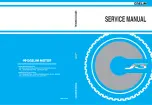
sembly (B,
Figure 33
) aligns with the Woodruff key
(or the crankshaft keyway) when the cylinder is at
top dead center.
10. Position the flywheel so the two marked teeth
(A,
Figure 41
) align with the Woodruff key in the
crankshaft. Slide the flywheel onto the crankshaft
so the keyway engages the Woodruff key (B,
Fig-
ure 41
), the starter wheel gear (C) engages the
starter idler gear, and the timing gear (D) engages
the cam chain drive assembly.
11. Install the washer (C,
Figure 31
) and flywheel
nut (B). Hold the flywheel with the sheave holder
and torque the flywheel nut to 175 N•m (129 ft.-lb.).
Make sure the sheave holder does not cross any
raised portion (A,
Figure 31
) of the flywheel.
12. Install the alternator cover as described earlier
in this chapter.
Flywheel Inspection
1. Clean the parts in solvent and dry them with
compressed air.
WARNING
Replace a cracked or chipped fly
wheel. A damaged flywheel can fly
apart at high speed, throwing metal
fragments into the engine. Do not at
tempt to repair a damaged flywheel.
2. Inspect the flywheel (
Figure 42
) for cracks or
breaks. Make sure the magnet is free of all metal
parts.
3. Check the flywheel tapered bore and the crank-
shaft taper for damage. Replace damaged parts as
necessary.
4. Inspect the threads of the flywheel nut bolt. Re-
place the nut if the threads are stretched or dam-
aged.
5. Inspect the dogs (A,
Figure 38
) and teeth (B) on
the timing gear for chips, cracks or other signs of
damage. Replace the timing gear if there is any
damage. If the teeth on the timing gear are damaged,
also check the teeth on the gear of the cam chain
drive assembly.
6. Check the operation of the starter clutch as de-
scribed in this section.
146
CHAPTER FIVE
40
41
42
43
















































